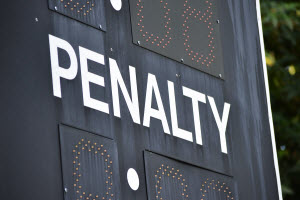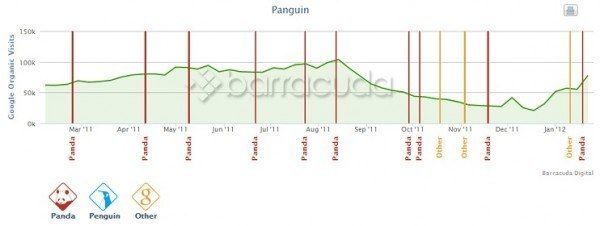 With so many Google updates leading to so many reasons why websites can suddenly or gradually lose traffic and rankings, it can be hard to know where to start. In this post I’ve looked at the different types of Google penalties (and those that are not, strictly speaking, penalties at all) to help you diagnosis your site’s issues and get on the road to recovery.
With so many Google updates leading to so many reasons why websites can suddenly or gradually lose traffic and rankings, it can be hard to know where to start. In this post I’ve looked at the different types of Google penalties (and those that are not, strictly speaking, penalties at all) to help you diagnosis your site’s issues and get on the road to recovery.
The Big Boys: Panda and Penguin
While there are now many other algorithm updates, some with equally quirky names, the Penguin and Panda algorithm updates still remain the two biggest updates overall and have claimed the rankings of many more sites than most other updates put together.
That said, the two are still very different and it’s important to understand what each one targets and how you can hope to combat them.
Google Panda – Low Quality, Duplicate and Thin Content

One of the original and most impactful Google algorithm updates is Panda, which targets content quality. Originally, Panda was introduced to combat spammy content techniques such as article spinning, scraping content and creating similar pages for numerous keyword variations.
Since it was first set live in February 2011, numerous Panda updates have been released which each increased the efficiency in which Google was able to identify spammy or unnatural content techniques and began to look for other low-quality content issues that Google didn’t want to be including in search results, such as pages thin on content or featuring content scraped from other sites.
If you suspect that you might have suffered at the hands of Panda, it is critical that you get your content up-to-scratch and resolve and potential issues. Some things to look out for include:
- Duplicate content from external sources – use duplicate content checking tools such as Copyscape to identify any external sites which duplicate your site content.
- Pages thin on textual content – review your site pages and ensure that each contains at least 250-300 words of unique textual content. If any pages are short, develop them or consider if they’re needed at all. If you remove any pages, remember to redirect the URLs to the most relevant live page.
- Carry out a content audit – is your content delivering value to users? Do you have pages that hardly ever get visited? Use Google Analytics to review your worst-performing pages and consider what content is out-of-date, unnecessary or not useful.
Google Penguin – Unnatural Links and Spammy Anchor Text

Like Panda, Penguin updates can have a big impact on search engine rankings. In some cases, businesses have seen their sites disappear from the rankings literally overnight following a Penguin release.
Penguin targets unnatural and black-hat link building techniques that breach Google’s Link Schemes guidelines. The sorts of techniques that could cause your site to fall foul of a Penguin update include:
- Paid or incentivised links that do not include the rel=”nofollow” attribute
- Reciprocal linking and link exchange schemes, including link wheels
- Excessive use of low quality link building tactics such as article marketing or guest posting
- Excessive use of keyword-rich link anchor text (the clickable text of a link)
Any website which has invested in “old-school” SEO techniques in the past, typically pre-2010, should be considered at risk of a link-related penalty if precautions aren’t taken to clean and protect the link profile.
If you suspect that you have suffered following a Google Penguin update or data refresh, it’s critical you start evaluating your backlinks and taking action against any links that could be considered spammy or unnatural.
Backlink analysis can be a complex and time-consuming task, particularly if a site has a lot of links pointing back to it. It’s important to use as many backlink analysis tools as possible to collect your link data to ensure you get a truer picture of your overall link profile. Then it is a case of analysing your links to establish whether each is natural and valuable or potentially spammy and in breach of guidelines.
Any spammy or unnatural links that you uncover should be removed if possible, but can be disavowed using the Google Disavow Tool if removal is unachievable.
Manual Action Penalties

The true ranking “penalty” is a manual action penalty, where a member of Google’s Webspam Team has identified something about your site that breaches their Webmaster Guidelines.
There are many reasons why you might be hit with a manual action penalty, but these will always be announced to you via a message in Google Webmaster Tools. This message will indicate the effects of any action taken as well as the reason for it.
For example, if they have detected a high number of unnatural links pointing to your site, they may issue a partial-match penalty to take action against some of those inbound links. In more serious cases, they might issue a site-wide penalty which affects the ranking of your site as a whole. This could mean that your site is completely removed from the search engine’s index until you resolve the issue and request re-inclusion via a reconsideration request.
Recovering from a manual penalty can take a lot of time and investment, depending on the type of action taken and the circumstances surrounding it. For more information on the different types of manual penalties and how to combat them, please see my earlier post on the impact of a manual penalty, which looks at each of the main types in much more detail. For a step-by-step guide on recovering from a partial match unnatural inbound links penalty, you might find my anonymous case study and guide useful.
Other Google Algorithm Updates
There are a number of other algorithm updates which could have had a detrimental effect on your site. Here are some of the most impactful ones, although you can find more information on all the updates Google has released here.
Google Pigeon Update – Targeting Local SEO & Maps
The Google Pigeon update arrived in July 2014 and shook the local search engine results and map listings quite significantly. Businesses which didn’t operate on a local level generally didn’t see any effect, whereas those targeting local or specific areas were likely to see some changes in the way their business appeared or didn’t appear in Google.
This was the result of Google changing the way it measured and handled local data about websites and brought the way they handled local signals more in line with the way the core algorithm works.
For more information on Google Pigeon, please check out a recent post from my colleague Ali Moghadam on the subject here.
If you are a local business and feel as though your site suffered following Google Pigeon, make sure your local SEO is up-to-scratch:
- Ensure your address and contact details are in the header or footer of every page of your site, not just on the contact page.
- Secure and populate strong local listings including a verified Google My Business page.
- Where relevant and natural, include your location in your page content.
Hummingbird “Update” – Not An Algorithm Update; A New Algorithm
Google Hummingbird is often mistakenly referred to as a Google algorithm update when in actuality it was a complete redesign of the algorithm itself. It was considered to be the biggest shake up since Caffeine (back in 2010) although surprisingly few websites saw a major impact.
You can read more about the Hummingbird algorithm here on Search Engine Land.
If you saw major changes in your organic traffic or web rankings around 20th August 2014, it could be that your site was no longer in favour when the new algorithm went live.
If this is the case, you should review your site content and make sure that you can say confidently that yours deserves to rank above the other websites for the sorts of keywords you are targeting:
- Are you providing quality, unique content that fits the needs of the user?
- Does your site look professional and trustworthy?
- Is it easy to use and navigate and easy for users to find what they’re looking for?
Focus on delivering a site designed to serve users, answer their questions and solve their problems. If you haven’t already, implement a blog and post useful, unique posts regularly to help become a leader in your industry.
Payday Loans Updates – Targeting Notoriously Spammy Industries
There have been a number of updates known as Payday Loans updates, starting in June 2013 through to June 2014. These updates targeted infamously spammy industries and search queries such as payday loans, gambling and pornography.
You can read more about the Payday Loans updates here on Search Engine Land.
If your business operates in an industry where the search queries and search engine results tend to be spammy or excessively manipulated by webmasters in the past, it can take a lot of work to recover and compete again.
Many sites operating in industries such as the payday loans niche repeatedly close down sites and start up new ones each time they get devalued in the SERPs. This is far from ideal, but some businesses choose to operate in this way rather than invest steadily in building up a strong brand and website built to last.
A Tool to Help Diagnose an Algorithmic Penalty
If you suspect an algorithmic penalty could be responsible for your website’s issues, the Panguin tool by Barracuda is a really useful tool to help you reach a diagnosis. Simply connect your Google Analytics account and the tool will overlay your organic traffic data with Google algorithm updates, helping you identify what happened around the time that your traffic tanked.

Please note that this tool is only really useful if you have (or at least had) enough organic traffic coming to your site to spot trends. If you only have a few visits a day, it can be impossible to identify spikes and drops.
Still Need Help?
If you’re still stuck or would like an expert analysis of your site and diagnosis of potential problems, please don’t hesitate to get in touch.
Images by Bigstockphoto.com

Leave a Reply